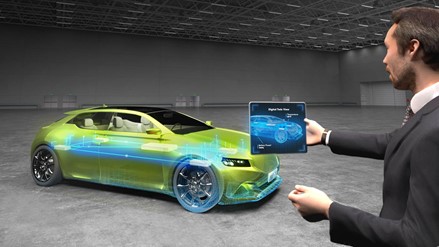Intelligent Connected Vehicles and Their Digital Twins in the CloudIntelligent Connected Vehicles and Their Digital Twins in the Cloud
New vehicle E/E architectures and the move to software-defined vehicles, along with new vehicle processing platforms, can take advantage of the vehicle data explosion and create new data-driven opportunities.
November 29, 2022

In a world where machines are increasingly connected, data-driven and software-defined, digital twins can be game-changing. Providing real-time, virtual models of machines, digital twins are already proving to be valuable in the industrial and IoT space.
There is also a huge potential for digital twins in the automotive industry. With edge processing technology that provides vehicle-wide, real-time data and secure access to the cloud, OEMs can improve their vehicle designs, streamline maintenance processes, reduce costs and deploy new features.
Intelligent connected vehicles are made possible through a convergence of many technologies across the vehicle with high-speed wireless connectivity to the cloud to provide a new vehicle edge-to-cloud infrastructure that enables many new data-driven opportunities. Just think what you could do with new levels of vehicle processing, access to vehicle-wide data and the power of the cloud.

Digital twin 2
Increasing Data and Connected Vehicles
Vehicle data has become central to the automotive industry, with many companies focusing on data-driven products and services. The rapid growth in vehicle data is driven by the increased use of sensors, including radar, lidar, ultrasonic, pressure, temperature and ultra-wideband radar sensors, to name but a few. With this increased access to internal vehicle data and the proliferation of high-bandwidth and faster Ethernet speeds and powerful multicore processors, vehicles are becoming more connected.
According to IHS Markit, about 82 million connected vehicles will be shipped by 2027. New technologies and many collaborations with our partner ecosystem from vehicle-to-cloud (V2C) take advantage of this data. But it is not only for test vehicles; vehicle data-driven insights can help support production vehicles throughout their lifecycle.
There is a combination of advanced processors in the vehicle, providing higher-bandwidth networking and machine learning (ML) acceleration with centralized access to vehicle data. Wireless technologies, such as Wi-Fi 6 and 5G, offer higher-bandwidth, more secure connections and lower latency to enable new vehicle-to-everything (V2X) services. Advanced automotive cloud services, such as hyperscalers, provide scalable cloud computing, networking and data storage services. Together these technologies bring a raft of new possibilities.
To meet the needs of the three automotive megatrends – connected, electric and autonomous – and to reduce vehicle complexity, new vehicle electrical/electronic (E/E) architectures are shifting from hardware-defined to software-defined with more modern domain and zonal architectures. Instead of adding new functions with boxes (ECUs), we are moving to a software-defined vehicle world that changes the game, impacting continuous integration and continuous deployment from the cloud with over-the-air (OTA) updates.
Hardware ECUs transform into virtual ECUs running as software tasks on a multicore processor, enabling automakers to move faster to develop and deploy updates and add new features to vehicles. Connectivity is key to the success of autonomous and electric vehicles, which need vehicle data insights to improve continuously over time.

Digital twin 4
The Digital Twin Concept
Digital twins can be used during manufacturing, but where it gets exciting is monitoring and modeling of production vehicle fleets. Now that we have real-time, end-to-end V2C infrastructure available for production vehicles, we can leverage the valuable real-time vehicle data to drive automotive digital twins. They can be diverse, from chips to ECUs or systems to complete vehicles. To touch on a few examples, they can include component aging or prognostics to identify failures before they occur, vehicle perception accuracy and improvements, battery and energy management optimization, and complete electric-vehicle propulsion modeling to improve efficiency and, ultimately, range.
To illustrate how digital twins can be applied, let us look at a battery management system (BMS) for an EV (pictured, above). A connected cloud battery twin runs predictive algorithms that estimate the remaining useful life of the battery and monitors for aging and potential problems. The performance advantage of highly accurate sensors with predictive algorithms running in the digital twin provides invaluable insights to carmakers.

Lars Reger NXP
ConclusionNew vehicle E/E architectures and the move to software-defined vehicles, along with new vehicle processing platforms, can take advantage of the vehicle data explosion and create new data-driven opportunities. In particular, the vehicle edge-to-cloud infrastructure through ecosystem collaboration has been key to enabling a vehicle data lifecycle that combines vehicle hardware and software and powerful cloud resources to support digital twins and ML. Together these provide valuable insights for carmakers and allow intelligent connected vehicles to improve over time.
There is much activity today around ML, but digital twins are now promising to bring new value propositions to monitor vehicles effectively in the cloud, drive optimizations and efficiencies, and identify potential issues before problems occur. This capability provides carmakers with powerful insights and allows them to provide better customer experiences - keeping customers happy and helping build brand loyalty.
Lars Reger (pictured, left) is Chief Technology Officer for NXP Semiconductor.
About the Author
You May Also Like